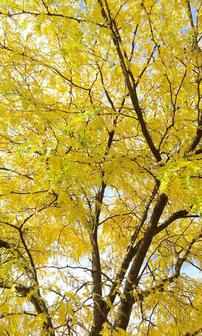 | ||||
Why Do Deciduous Leaves Change
Color in the Fall?
CLASS NOTES from Science Prof Online
Temperate climates provide a clear and beautiful sign of the approaching winter when autumn leaves begin to change color. This brilliant show inspires many travelers to head north for breathtaking fall color tours.
Why Do Leaves Change Color in Autumn?
But what actually causes leaves to change from summer’s green to the signature colors that precede the fall leaf drop?
To understand this transformation, it is helpful to first know what the job of a leaf actually is. Why do trees have leaves in the first place?
Leaves Are Plant Food Factories
Plants and other photosynthesizing organisms have a very special talent.
SPO VIRTUAL CLASSROOMS
 | ||||||
They can turn sunlight into food. It is a pretty neat trick that only photoautotrophs can do (photo=sun; auto=self; troph=feeder).
In order for plants to make food energy, they need water,carbon dioxide (CO2) and sunlight. From this special combination, a plant is able to make its own food, in the form of glucose, a type of sugar. Plants then use the glucose as food energy to live and grow. In order to harvest sunlight energy, plants have a green pigment called chlorophyll. This pigment is what makes a plant's leaves appear green.
Page last updated 10/2015
The SPO website is best viewed in MIcrosoft Explorer, Google Chrome or Apple Safari.
See Page 2 for time-lapse video of a science fall foliage!
You have FREE access to a large collection of materials used in a college-level introductory biology course. The Virtual Biology Classroom provides a wide range of free educational resources including PowerPoint Lectures, Study Guides, Review Questions & Practice Test Questions.
Bright yellow ash leaves in Michigan autumn.
It is very energetically expensive for a tree to run its leafy food factories in the winter, when, due to freezing temperatures, water transport (from the ground into the tree’s trunk and leaves) becomes a problem. It is more energy efficient for the tree to shut down operations in the winter and go dormant.
The Pigments in Leaves
When a tree begins its preparations for dormancy, the chlorophyll pigment begins to break down. But chlorophyll is not the only pigment that a plant has at its disposal. There are also other colored pigments, such as carotenoid and anthocyanin, but their appearance is typically masked by the green chlorophyll.
Carotinids are pigments that create the bright yellows and orange leaves, colors that we also see in some fruits and vegetables. Anthocyanins impart a red color to leaves, as well as to cranberries, red peppers, cherries, and strawberries.
The Food Factory Shuts Down for Winter
As winter approaches, the days get shorter and cooler. These changes in day length and temperature trigger trees to essentially hibernate for the winter.




